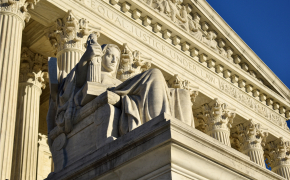2024 Litigation Look Ahead Series: Challenges to Administrative Law Judges, Judicial Review Process Could Limit Executive Power
B&D is pleased to present the third installment of our 2024 Litigation Look Ahead series. (Read part two on the increased application of the major questions doctrine here.) In this section of the compilation, our litigation team highlights two pending Supreme Court cases examining the constitutionality of appointed administrative law judges and the judicial review process under the Administrative Procedure Act. The outcome of these cases could have significant ramifications on the enforcement power of the executive branch and the deadline for challenging final agency actions.
Securities and Exchange Commission v. Jarkesy, No. 22-859
Case Summary
The Securities and Exchange Commission (SEC) brought a civil enforcement action against George Jarkesy and an investment advisor, alleging securities fraud. SEC utilized the agency’s in-house administrative adjudication procedures to pursue the matter. SEC’s administrative law judge (ALJ) found Jarkesy and his co-defendants liable and ordered various remedies. The defendants pursued administrative appeals, unsuccessfully, and then sought review in the U.S. Court of Appeals for the Fifth Circuit. In May 2022, the Fifth Circuit held that the SEC’s use of ALJs to enforce civil securities laws violates the accused’s Seventh Amendment right to a jury trial. The Fifth Circuit further found the SEC’s administrative courts unconstitutional because the appointed judges are protected from removal, in violation of Article II of the Constitution, and Congress improperly granted the SEC legislative power by allowing the agency to decide whether to sue in administrative or federal court. The SEC petitioned the U.S. Supreme Court for certiorari, which it granted, and oral arguments took place on November 29, 2023.
Implications
The case challenges the constitutionality of appointed ALJs to resolve disputes. While Jarkesy only pertains to the SEC’s use of ALJs to enforce securities laws, EPA and many other federal agencies rely on in-house civil administrative proceedings to enforce laws, in lieu of civil actions in court. If the Supreme Court affirms the Fifth Circuit’s decision, the ruling could have broader impacts by eliminating or restricting the ability of other agencies to use ALJs. Such a result would channel more enforcement cases to the courts, a more time-consuming, resource-intensive, and costly process. Limiting the enforcement power of the executive branch would greatly impact how agencies enforce statutes and their regulations. A ruling in favor of the petitioners could also call into question the past decisions of ALJs. To minimize the enormous consequences of such a decision, the Supreme Court may find a middle ground, focusing on limitations on the Seventh Amendment right to a jury trial in the context of agency enforcement actions.
Corner Post, Inc. v. Board of Governors of the Federal Reserve System, No. 22-1008
Case Summary
The U.S. Supreme Court is considering a circuit split regarding the six-year statute of limitations for Administrative Procedure Act (APA) challenges, a cornerstone of environmental litigation. Under the APA, any person who claims to have been injured by an agency’s action has the right to go to court to challenge the action, but they must file their action within six years after the “right of action first accrues.”
In this case, Corner Post, Inc., the operator of a convenience store and truck stop, challenged the Federal Reserve’s debit card interchange rules, known as Regulation II, which set the range of fees larger card-issuing banks can charge merchants for processing debit card payments, asserting the rules were promulgated in violation of the APA. The rules were adopted in 2011. Corner Post, which opened for business seven years later in 2018, argued that the statute of limitations does not begin to run until a plaintiff suffers a “legal wrong” or becomes “adversely affected or aggrieved,” as required by 5 U.S.C. § 702. Consequently, the statute of limitations did not apply to bar its claim because the “adverse affect” of the challenged rule did not occur until 2018.
A North Dakota federal district court dismissed the case as untimely because the six-year statute of limitations expired in 2017. The U.S. Court of Appeals for the Eighth Circuit affirmed, holding that the six-year statute of limitations for facial challenges to regulations brought under the APA accrues upon publication of the final rule. In this ruling, the Eighth Circuit followed the majority position that the APA claims first accrued upon publication of the final agency action. Corner Post, Inc. filed a petition for certiorari, which was granted, and the case is now before the Supreme Court.
Implications
The Supreme Court heard oral arguments in the case on February 20, 2024. The precise question before the Court is whether a facial challenge to a regulation, brought under the APA, accrues when the regulation is first published or when the plaintiff first suffers a related “legal wrong” or an “adverse affect.” At oral arguments, the Justices questioned Corner Post’s position. In particular, Justice Ketanji Brown Jackson seemed concerned that a ruling favoring Corner Post would put every agency rule in effect in question, subject to facial challenges whenever a regulated entity claims to have first suffered a related harm.
The outcome of this case could have major impacts on the ability of regulated entities to assert facial challenges to regulations under the APA. If the Supreme Court reverses and holds that the statute of limitations accrues when a party is first injured, plaintiffs will be permitted to challenge a regulation—no matter the promulgation date—so long as they commence the cause of action within six years of the initial harm. Such a holding could open floodgates within the judicial system, creating a pathway for parties to challenge long-settled regulations, leading to perennial regulatory instability.
In Conclusion
The decisions in both Jarkesy and Corner Post could significantly affect the executive branch’s ability to enforce statutes and regulations as well as litigants’ options for bringing judicial challenges. In either case, Supreme Court decisions in favor of the petitioners would magnify the effect of other decisions that may alter how courts approach administrative law questions, such as the pending decisions regarding Chevron deference.
A ruling in favor of the petitioner in Jarkesy could unravel a complex system of administrative adjudication and expedite a litigant’s access to the crowded federal courts. A ruling in favor of the petitioner in Corner Post could change how courts apply the statute of limitations for APA challenges to agency actions and open the door to such claims years, or even decades, after regulations are published. Such rulings would eliminate long-standing obstacles in the path to federal court.
Furthermore, if the Supreme Court strikes down or limits Chevron deference, vastly different criteria would apply when federal courts review agency actions. This combined impact of the three cases could potentially mark a revolution in administrative law litigation, with the landscape fundamentally altered to provide regulated entities more opportunities to challenge agency action in federal court, freed, to some extent, from the agency-favorable doctrine of Chevron deference, allowing the judiciary more opportunity to shape agency action.
Coming Soon in our Litigation Look Ahead Series…
In our 2024 Litigation Look Ahead series, we highlight cases – environmental and otherwise – that could have notable impacts on the regulated community or lead to changed regulatory approaches. Upcoming installments of the series will examine Fifth Amendment takings, the Comprehensive Environmental Response, Compensation, and Liability Act (CERCLA), and natural resource law. In case you missed it, read part two of the series covering the increased application of the major questions doctrine.
B&D’s litigators are actively involved in and monitor cases in courts nationwide. With decades of experience in toxic torts, class actions, Superfund and site remediation, enforcement defense, regulatory challenges, and business and contract disputes, our litigation team is well-equipped to handle diverse legal matters.











